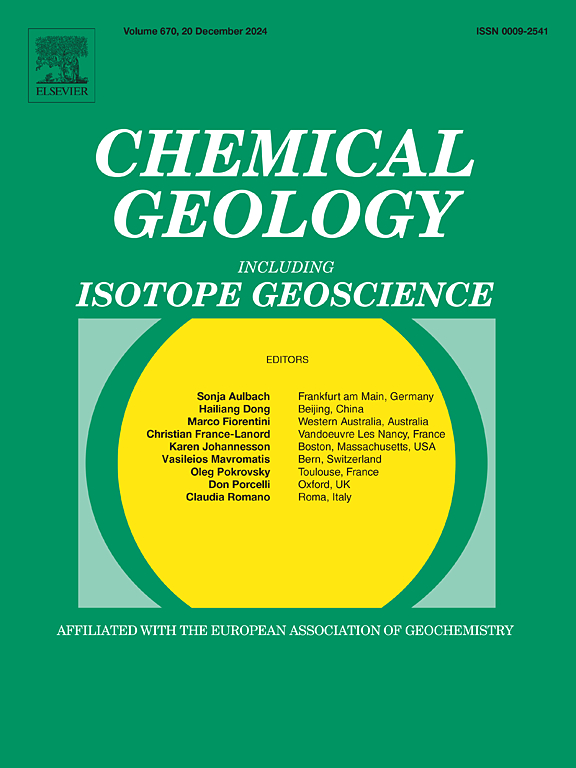Carbonatite evolution at St Honoré (Canada), the apatite record
IF 3.6
2区 地球科学
Q1 GEOCHEMISTRY & GEOPHYSICS
引用次数: 0
Abstract
The purpose of our study was to test the hypothesis that apatite provides a detailed record of the evolution of carbonatitic magmas. To this end, we investigated the chemistry and textures of apatite in the various rock units (banded carbonatite, biotitised syenite, biotitite, magnetite-biotite rock and massive carbonatite) of the St Honoré carbonatite using a combination of micro-analytical and imaging techniques. Subtle changes in the uptake of a variety of trace elements during growth led to corresponding changes in the cathodoluminescence response that are recorded as distinct zones in the apatite. In the banded carbonatite, the first apatite to crystallise was fluid/mineral inclusion-bearing and was followed by apatite displaying oscillatory zoning and, in turn, by apatite that replaced the earlier apatite through dissolution-reprecipitation. In contrast, the earliest apatite in the biotitised syenite displays oscillatory zoning and was variably replaced by later apatite. The subsequent crystallisation stages duplicate those of apatite in the banded carbonatite. Apatite crystallisation in the magnetite-biotite rock duplicated the stages recorded by apatite in the banded carbonatite. Finally, the apatite of the massive carbonatite contains representatives of all the apatite types mentioned above.
A model is presented in which inclusion-rich apatite records aqueous‑carbonic fluid exsolution from the magma, oscillatory zoned apatite records periods of quiescent growth and replacement apatite records dissolution-reprecipitation induced by the differential stresses that accompanied fluid overpressures. Apatite in the massive carbonatite was incorporated from the other units. Based on the above model, we propose that banded carbonatites at St Honoré and other similar complexes formed during an early stage of carbonatitic magma emplacement, when thermal gradients between the magma (hot) and the host rocks (cooler) were steep and the calcite liquidus was reached before significant biotitisation. With the emplacement of additional batches of magma, the thermal gradient was gradually flattened and biotitisation was extensive, producing massive biotitite. This hypothesis explains the occurrence, spatial distribution and genesis of the biotitite (glimmerite) and banded carbonatite observed in many carbonatite complexes.
加拿大圣奥诺瓦斯碳酸盐岩演化,磷灰石记录
我们研究的目的是验证一个假设,即磷灰石提供了碳酸盐岩岩浆演化的详细记录。为此,我们结合显微分析和成像技术,研究了圣奥诺瑞斯碳酸岩不同岩石单元(带状碳酸岩、生物正长岩、黑云母、磁铁矿-黑云母岩和块状碳酸岩)中磷灰石的化学成分和结构。生长过程中各种微量元素摄取的细微变化导致了相应的阴极发光响应的变化,这些变化被记录为磷灰石中的不同区域。在带状碳酸盐中,首先结晶的磷灰石为流体/矿物包裹体,其次是磷灰石,磷灰石显示振荡带,然后是磷灰石通过溶解-再沉淀取代早期磷灰石。生物正长岩中最早的磷灰石呈现振荡分带,并逐渐被后来的磷灰石所取代。随后的结晶阶段与带状碳酸盐中磷灰石的结晶阶段相同。磁铁矿-黑云母岩石中磷灰石的结晶阶段与带状碳酸盐中磷灰石所记录的阶段重复。块状碳酸盐岩的磷灰石含有上述所有磷灰石类型的代表。
本文章由计算机程序翻译,如有差异,请以英文原文为准。
求助全文
约1分钟内获得全文
求助全文
来源期刊

Chemical Geology
地学-地球化学与地球物理
CiteScore
7.20
自引率
10.30%
发文量
374
审稿时长
3.6 months
期刊介绍:
Chemical Geology is an international journal that publishes original research papers on isotopic and elemental geochemistry, geochronology and cosmochemistry.
The Journal focuses on chemical processes in igneous, metamorphic, and sedimentary petrology, low- and high-temperature aqueous solutions, biogeochemistry, the environment and cosmochemistry.
Papers that are field, experimentally, or computationally based are appropriate if they are of broad international interest. The Journal generally does not publish papers that are primarily of regional or local interest, or which are primarily focused on remediation and applied geochemistry.
The Journal also welcomes innovative papers dealing with significant analytical advances that are of wide interest in the community and extend significantly beyond the scope of what would be included in the methods section of a standard research paper.
 求助内容:
求助内容: 应助结果提醒方式:
应助结果提醒方式:


